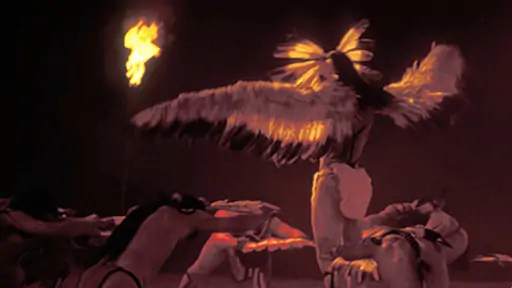Indigenous Calendar August, 2014: The Cherokee Eagle Dance

In North Carolina, in the United States, each year the small town of Cherokee hosts the annual Festival of Native Peoples. It is usually held around mid-July and last year's festival (the ninth) took place at that time. Although it is hosted on their reservation by the Eastern Band of the Cherokee Nation, it is far from limited to Cherokee culture or Cherokee participants. A wide variety of traditional live performance art — including music, song, dance, storytelling and even "pole flying" — is given by an equally wide variety of indigenous people from across the Americas. In addition to the performances, there are exhibitions and commercial markets showcasing indigenous art of the Americas.
Just a few days after this festival took place and five hundred kilometers (three hundred miles) east in Raleigh, North Carolina, the State Legislature passed a bill recognizing the Cherokee language as one of the "foreign" languages sanctioned by the University of North Carolina for students to fulfill their foreign language study obligation as part of their matriculation.
The Cherokee are the only indigenous people of North Carolina recognized by the US Federal Government.
The Cherokee people themselves are relatively wealthy compared to many other indigenous peoples in the US. A recent disclosure claims that the net worth of the Eastern Band is over US$ 700 Million. This is partly because the area has been highly developed for tourism over the past twenty-five years or so. Aside from the annual Festival of Native Peoples there are attractions in Cherokee all year round — particularly through the summer.
One such attraction is an outdoor drama that tells the history of the Cherokee: Unto These Hills. It has been performed since 1950 making it the third oldest outdoor historical drama in the US. One particularly striking scene shows an ancient Cherokee dance: The Eagle Dance. Many traditional Cherokee dances are named after animals and the Eagle Dance is one of the most important.
If you enjoyed reading this article, please consider supporting independent, advertising-free journalism by buying us a coffee to help us cover the cost of hosting our web site. Please click on the link or scan the QR code. Thanks!


